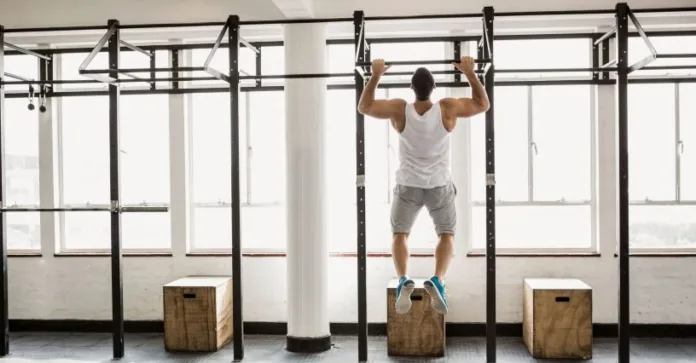Pull-ups may seem like a demanding exercise at first glance. However, its effectiveness in building muscle strength and endurance, as well as shaping the physique, makes it worth adding to your workouts. In this guide, we’ll discuss the benefits of pull-ups, types of barbell grips, proper technique, and common mistakes that can hinder your goals. We’ll also give you tips on how to start barre training effectively and safely.
Pull-ups – which muscles work?
The pull-up, or pull-ups, is a complex strength exercise that engages multiple muscle groups at once, making it an effective part of a complete workout. The greatest work is done by the muscles of the back (latissimus dorsi, quadriceps), shoulder girdle, biceps, and rectus abdominis and obliques . To a lesser extent, but still the extensors of the back are involved (they help to raise the body and maintain a stable position) and the muscles of the chest, especially their upper part.
Different grips and ways of doing pull-ups can further emphasize the work of the muscle parts to a certain extent. When pulling up on a bar with an underhand grip (palm facing you, thumbs out), the muscles are engaged in the following order:
- biceps arm,
- big back,
- pectoral arch,
- the upper part of the quadriceps (caps),
- right abdominal,
- gluteus maximus.
When performing pull-ups on a pull-up bar (thumbs facing each other, inside of palms outward), the main role is played in turn by:
- big back,
- pectoral arch,
- right abdominal,
- trapeze,
- abdominal oblic,
- biceps arm.
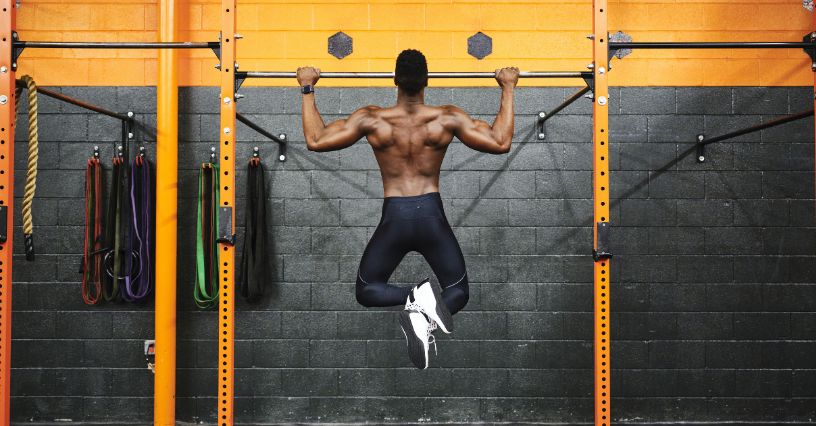
Pull-ups – effects
Pull-ups are a bodyweight exercise that, when performed regularly, effectively improve the strength and endurance of the back, shoulder and arm muscles and are great for building a sculpted physique.
To maintain a stable body position during pull-ups, the core muscles are put to work, which contributes to their strengthening and is beneficial for improving posture and helping to relieve back pain. Shoulder mobility is also improved, which will be beneficial for performance in other exercises, e.g. pulling the bar (overhead press), etc
Systematic performance of pull-ups has a positive effect on the cardiovascular system. Another benefit is that it boosts metabolism, burns a considerable amount of calories and supports fat reduction. Pull-ups are a complex (multi-joint) exercise, which means they burn more calories than isolated exercises like push-ups.
By including pull-ups in your training plan, you will notice an improvement in your grip strength, which will be useful for sports activities such as rock climbing, tennis or martial arts. A strong grip will allow you to better stabilize your hand and wrist movements, and this will reduce the risk of joint strain or injury during a variety of sports. Pull-ups mimic natural movements that can also be useful in everyday life, for activities such as: lifting, climbing, carrying shopping bags or even opening jars.
To get maximum benefits from pull-ups, it is important to do them correctly, control the movements and gradually increase the difficulty of the workout. Introducing more pull-ups and using different grips can add even more variety to your workout and contribute to more comprehensive muscle development.
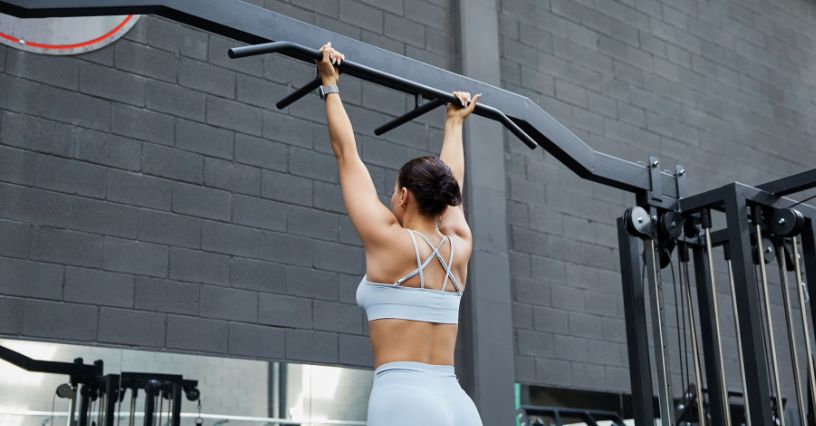
Over hand or over hand ie bar grip types
Here are some of the main types of bar grips, which allow for many training variations and engage different muscle groups :
- overhand grip – the most classic grip used for pull-ups. The palms in the overhand grip are facing you, with the top of the hand facing you and the thumbs facing each other. This is a great option when you want to strengthen your back muscles in particular. Use the overhand grip if you want to get a V shape;
- overhand grip – often used by beginners. When shooting, the palms face inward, toward the face, and the thumbs face outward. This is how you should pull up if you want to improve the strength and appearance of your biceps and forearm muscles;
- neutral grip – the palms are oriented towards each other (on two handles placed parallel), thus obtaining an intermediate grip between the grip with the hand down and the grip with the hand up;
- wide grip – the hands are positioned on the bar at a distance greater than the width of the shoulders;
- narrow grip – hands are close together. This grip engages the shoulder muscles more and is often used to emphasize the work of the biceps muscles;
- mixed grip – in this grip, one hand holds the bar with an underhand grip and the other with an overhand grip. This grip can help increase stability and strength during pull-ups;
- one hand grip – advanced version of pull up. Hold the bar with one hand and the other can rest on your chest.
Using a variety of grips in pull-up training prevents monotony and helps with overall strength development. However, remember that it is important to maintain proper technique when performing pull-ups, regardless of the grip used. This will help you avoid injury and get maximum results from your training.
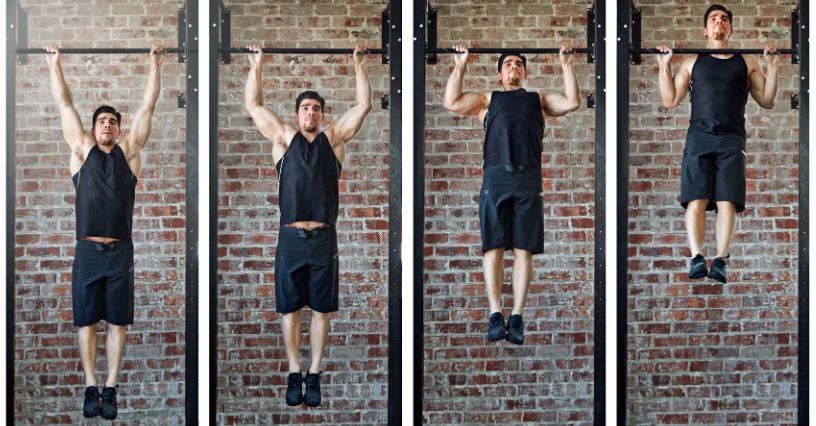
Pull-ups on the bar – the correct technique
Correct deadlift technique is essential for efficient and effective training and injury prevention. Here’s how to properly pull yourself up on a bar :
- Starting position: stand under the bar, jump up and grab it with a grip of your choice (depending on your goals and training level). To start, it’s a good idea to position your hands with the grip slightly wider than shoulder width. In a loose squat, keep your arms straight at the elbows, legs straight at the knees and body in one line. Tighten your abs – tuck your pelvis in and draw your navel towards your spine), looking slightly up.
- Movement: Squeeze your shoulder blades together (retraction) and lower yourself (depression), then with an exhalation begin to pull yourself up, pushing your elbows toward your ribs. Use your back muscles, not just your arms, to lift your body. Lifting should be controlled, not sudden. Avoid rocking. Keep your abdominal muscles tight to maintain stability. Pull up until your chin is over the bar.
- Return to starting position: Inhale and begin to lower your body back to the starting position in a slow, controlled movement. Make sure you are working to your full potential.
The most common mistakes during pull-ups
During pull-ups, the most common technical mistakes are :
- Inadequate gripping technique in relation to skill level or training objectives,
- incomplete range of motion (only a partial lifting of the body and not lowering to full extension),
- incorrect body position (does not keep a straight line of the body, swaying of the body),
- lack of tension in the abdominal muscles,
- incorrect rhythm – the negative phase, i.e. the descent, should last longer than the positive phase, i.e. the pull-up,
- excessive movements that increase the risk of elbow and wrist injury,
- there is no gradual increase in the difficulty of the workout or a constant level of difficulty,
- skipping warm-up before training, which increases the risk of injury.
It should not be forgotten that the quality of execution is more important than the number of repetitions. If you are not yet able to perform full pull-ups, start with the negative phases of the movement and gradually increase the difficulty of the workout. If you’re in doubt about your technique, it’s worth consulting a personal trainer.
How do you start pulling up? Tips for beginners
Are you at the beginning of your gym adventure? Have you made several attempts to do pull-ups without success? Or maybe you’re coming back to training after a long break and can’t get up? With exercises like Australian pull-ups and negative pull-ups, you’ll pave the way to successful pull-ups on the bar .
Be proud of the bar
A free hang on the bar with scapular activation is a good start on the way to a full pull up. To perform this exercise :
- stand under the bar, jump up slightly (you can climb on the box instead) and grab it by pulling it up (hands slightly wider than shoulders)
- Straighten your shoulders and lower your body, trying to maintain a stable position. Avoid swinging your body. Head in a neutral position, gaze straight ahead.
- inhale, pull your shoulder blades together and down, keep your elbows straight;
- hold your position for a few seconds and return to the original position;
- perform 3 sets of 5 repetitions.
Alternatively, you can start with just a stationary position – hold it for 10 to 30 seconds. Repeat for 3 to 5 sets.
Negative thrust
Another exercise to start with pull-ups is the negative movement, where we focus mainly on the phase of lowering the body from top to bottom (the so-called eccentric phase of the movement) .
How to do negative pull-ups:
- Stand in front of the bar on a raised platform (such as a box) so that your chin is over it.
- Grab the bar with an underhand grip (lighter variation) or an overhand grip wider than your shoulders.
- Begin to slowly lower your body down through its full range of motion.
- Perform 3-5 repetitions in 3-5 sets.
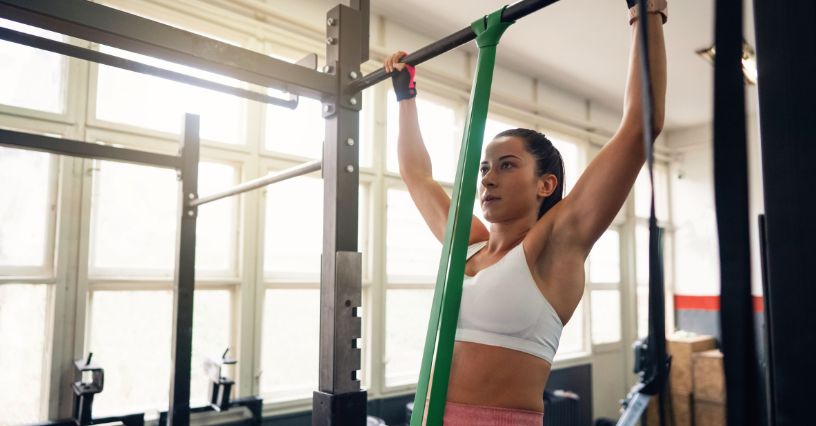
Tractions with power band
Once you’ve mastered the correct lifting position and pulling position, you can add a strength band to your workouts. The elasticity of the rubber band reduces the load at the bottom of the movement, which is especially beneficial for people who are new to pull-up training. Choose a thicker band to start with, and as you begin to pull up with ease, switch to thinner and thinner bands .
Here’s how to do power band pull-ups:
- Attach one side of the tape to the bar at the appropriate height.
- Sit under the bar and clamp it with a socket above or below, depending on your preference.
- Place the other end of the tape under the shin or metatarsal.
- Begin to perform the pull-up motion. Thanks to the elasticity of the rubber, you will feel additional support during the most difficult phase of the movement.
- Slow down the movement, lowering your body down with full control until your arms are again at full extension.
Australian Tractions
The Australian pull-up, or horizontal pull-up, is a multi-joint exercise that is a variation of the traditional pull-up, except that here the body remains horizontal rather than vertical. To perform them, you need a barbell, TRX straps, gymnastic rings or a support bar suspended at a suitable height. The greater the angle of the body to the ground, the easier the exercise will be .
Australian pull-ups using a barbell on a Smith machine – performance:
- Position the bar at chest height.
- Lower down to a sitting position. Legs straight, resting on the heels, the bar should be above the chest.
- Grip the bar with a grip slightly wider than shoulder width.
- Hang. Your body should form a single line. Pull your shoulder blades together and down. Tighten your abdominal muscles. Move the shoulders away from the ears.
- Begin to pull your body up, bringing your chest closer to the bar. Maintain tension in your back and shoulder muscles as you lift them. Don’t shorten your neck with your shoulders.
- With a controlled movement, lower your body to the starting position.
- Perform 10-12 repetitions in 2-3 sets.
How many reps and sets of pull-ups to start with?
The number of reps and sets during a pull-up bar workout can vary depending on your training goals and current fitness level. As a beginner, you can focus on performing 3-5 repetitions in 3-5 sets per training session. Rest for 1 to 2 minutes between sets. Train 2-3 times a week, taking at least one day off between barre sessions. As you progress and increase your strength, you can experiment with different variations of pull-ups and gradually develop your skills .
It is also important to warm up before each workout, listen to your body during exercise and avoid overexertion, give yourself time to rest between sets and take care to recover after exercise.


